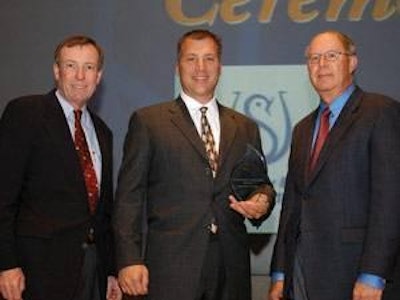
Cited for its innovative handling of byproducts, Manheim, Pa.-based Kreider Farms was presented the U.S. Poultry & Egg Association's "Family Farm Environmental Excellence Award" at the group's annual national convention in Atlanta earlier this year.
Kreider Farms was listed as the 26th largest in Egg Industry's 2008 Top Egg Company national rankings. The company has several farms with 27 poultry barns which can house up to 3.5 million layers.
Ron Kreider is the third generation of the Kreider family to manage the operation.
In addition to the egg business, Kreider Farms operates a 1,400 cow dairy on one of its farms. On this 1,500 acre farm, crops and houses for 920,000 laying hens coexist with the dairy. An innovative system has been devised to treat and enhance nutrient rich byproducts from both the egg and dairy operations.
Environmental Synergies
Egg wash water from the egg packing house is routed through the same treatment system used for processing the dairy waste. A series of wastewater treatment lagoons treats this combined waste stream. Dairy farm crop land is used as the final step in the wastewater treatment process as the lagoon effluent is used to irrigate the fields on the farm. Corn, alfalfa, rye grass and grass hay are raised for the dairy herd.
Solids from the dairy farm are run through a press and combined with the layer manure for composting. A good compost mix requires the proper blend of carbon, nitrogen and moisture to support rapid microbial growth and break down of the base materials. Manure from caged laying hens has plenty of nitrogen, but generally, a carbon source such as sawdust or straw must be added to compost it thoroughly. If the manure is dry when removed from the house, water needs to be added to the compost. The dairy manure solids provide the carbon source and moisture that the layer manure lacks and the combination composts well.
The compost bays have piping in the floor to provide forced aeration of the pile and speed the compost process. Poultry house mortalities are also composted in these piles. The compost is made of 25 percent chicken manure and 75 percent dairy manure solids. Most of the poultry litter and dairy manure generated on the farm is composted and sold to landscaping and fertilizer companies and nurseries. Kreider Farms has developed a composting method that combines the best characteristics of its layer and dairy wastes to produce valuable compost without having to add anything from off the farm.
New Waste Treatment System
Innovation did not stop with winning the USPOULTRY environmental award. In late February, Bion Environmental Technologies entered into an agreement with Kreider Farms to retrofit the existing manure and lagoon treatment system on Kreider's dairy farm.
Bion's nutrient management system is expected to reduce ammonia emissions from the treatment system and reduce the concentration of nutrients in the treated wastewater. This increase in wastewater treatment will mean that less phosphorous and nitrogen are sprayed on the fields during the irrigation process. The upgrades to the treatment system will cost between $3 million and $5 million, according to Bion.
The treatment system will generate credits under Pennsylvania's 2005 nutrient credit trading program, which Bion will sell to entities that have excessive discharge amounts. Bion plans to recoup its investment from the sale of the credits. This project would be the first to generate credits for ammonia reduction; the balance would come from reducing nitrogen and phosphorus. The system may be used to treat poultry waste as well.
Bay Friendly Farm
Kreider Farms operations are located in the Chesapeake Bay watershed. Federal and state agencies have worked with industry, agriculture and municipalities within the watershed to try to reduce the nutrient loading of the bay. In addition to poultry and dairy waste treatment, a stream running through the Kreider Farm has been fenced off to prevent dairy cows from soiling the water as it passes through on its way to the Chesapeake Bay.
Kreider Farms also operates a milk plant which processes, bottles and sells milk and makes farm fresh ice cream. The farm sells its eggs and dairy products to retail and wholesale outlets from Virginia through Boston. Online virtual tours of Kreider Farms operations are available at www.kreiderfarms.com




.jpg?auto=format%2Ccompress&fit=crop&h=167&q=70&w=250)













